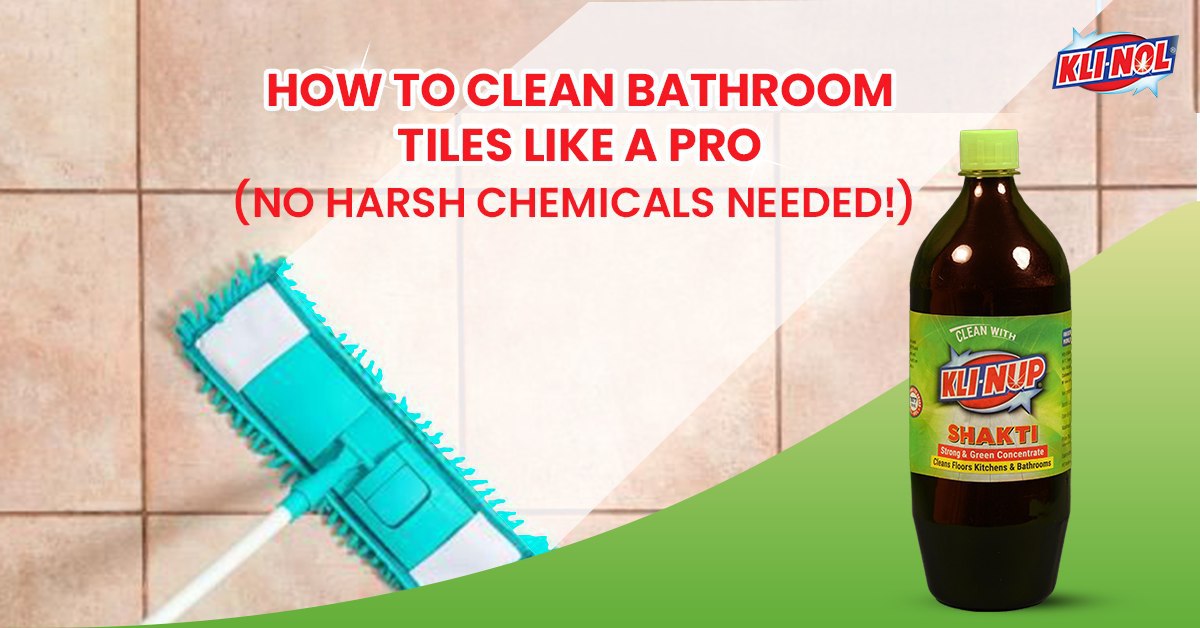Tired of grimy tiles, stubborn grout stains, and lingering mold but hate using harsh chemicals? You’re not alone. Many homeowners struggle to clean bathroom tiles effectively without resorting to toxic cleaners that harm indoor air quality and health.
This guide reveals how to clean bathroom tiles using safe, natural methods with ingredients you likely already have at home. You’ll discover how to remove grout stains, lift mineral buildup, and fight mold without harsh fumes or synthetic cleaners. In fact, a study published in the International Journal of Environmental Research and Public Health found that using household staples like vinegar and baking soda can reduce indoor pollutants by up to 60% (source).
Ready to deep clean your bathroom tiles the smart way? Let’s get started—and don’t forget to check out our eco-friendly tile cleaning kit designed for safe, powerful results—no chemicals needed!

Bathroom Cleaning Importance
Why Cleaning Bathroom Tiles & Grout Regularly Matters
Tiles in the bathroom influence both the appearance and your health and cleanliness. Bad cleaning practices usually lead to the formation of mold spores, soap scum and dirt on tile grout. Doing this can gradually damage your floor tiles, especially if they are ceramic or porcelain.
Also, mineral deposits in hard water stains can make your surfaces look dull if the problem is not looked after quickly. Constant dampness creates a breeding ground for bathroom mould, which is linked to respiratory problems and allergies. As a consequence, cleaning bathroom tiles well and often is a requirement for taking care of your bathroom.
If you don’t take care of your tiles regularly, they will likely get destroyed, there’s a chance for mould, and your home cannot stay clean. If it is not treated, tile grout might become permanently stained and gather bacteria. Routine care often helps tiles last for years longer.
People using Klinol’s plant-based products can maintain good tile hygiene without relying on harsh cleaning chemicals.
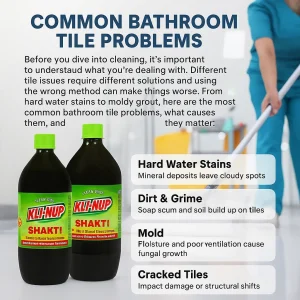
Bathroom Tile Cleaning Essentials
Common Bathroom Tile Problems You Must Know
Before you dive into cleaning, it’s important to understand what you’re dealing with. Different tile issues require different solutions and using the wrong method can make things worse. From hard water stains to moldy grout, here are the most common bathroom tile problems, what causes them, and why they matter:
| Problem | What It Looks Like | Cause | Why It Matters |
| Hard Water Stains | Cloudy patches near faucets and showerheads | Mineral-rich water drying on tiles | Makes surfaces dull and difficult to clean |
| Bathroom Mold | Black or green mold in corners and along grout lines | Moisture buildup in poorly ventilated areas | Affects indoor air quality and spreads spores |
| Discoloured Grout | Grout turning black, orange, or brown | Mildew, dirt, and soap scum buildup | Makes even clean tiles look dirty |
| Soap Scum | Filmy layer over tile surfaces | Reaction between soap and hard water minerals | Reduces shine and causes buildup over time |
| Tile Surface Erosion | Rough or pitted tile surfaces | Overuse of chemical cleaners or abrasive scrubbing tools | Damages tile finish and shortens tile lifespan |
Learning how to clean bathroom allows you to treat all these problems without harming what they are made of. If you see the cause of each problem, you are more likely to stop it by being consistent. There are now eco brands such as Klinol that provide multi-surface cleaners to manage these issues without harming your health or the tiles’ lifespan.
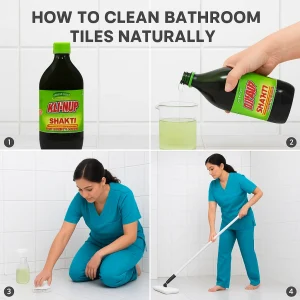
Natural Bathroom Cleaning Tutorial
Step-by-Step: How to Clean Bathroom Tiles Naturally
Now that you understand the most common tile issues, it’s time to take action using safe, natural solutions. This simple method relies on everyday ingredients like baking soda, white vinegar, and hydrogen peroxide to restore shine, eliminate grime, and clean grout lines without exposing your home to harsh chemicals.
Follow each step carefully to keep your bathroom tiles cleaner, healthier, and more attractive.
Step 1: Preparation
- Eliminate toiletries, rugs and bins from the bathroom.
- Let cool, fresh air in by opening windows or turning on a fan that moves hot air out.
- Always use safety gloves for cleaning, so you don’t injure your hands during scrubbing.
Step 2: Dry Dusting
Sweep the floor tiles and walls with a microfiber cloth or broom to remove hair, dust and debris. It results in smooth floor tiles that make cleaning much easier without mud being formed on wet days.
Step 3: Pre-Treatment with Baking Soda
- Use a lot of baking soda to cover the tile surface.
- Spent time cleaning the tile grout that is especially dirty. Since baking soda is a little bit abrasive, it doesn’t damage the tiles.
Step 4: Vinegar Spray Application
- Put the same amount of white vinegar and warm water into a spray bottle.
- Coat the baking soda over the surface.
- Give the vinegar solution some time to sit for 10–15 minutes to remove tile stains and gunk that can be loosened. The acetic acid in vinegar removes mineral deposits from hard water stains.
Step 5: Scrub Gently
- Use a soft-bristle brush or an old toothbrush for grout cleaning.
- Scrub in a circular motion for better penetration.
- Avoid wire brushes as they can damage ceramic cleaning surfaces and scratch glazes.
Step 6: Rinse and Wipe
- Mop the spill using a mop that has been dipped in warm water.
- Go ahead and dry your sink area with a microfiber to stop fresh hard water stains from forming.
- Use a squeegee on vertical surfaces to obtain a blemish-free look.
Step 7: Mould Spot Treatment
- Rub hydrogen peroxide onto parts of the house that have mould.
- Leave the dish soaking in hot water for 10 minutes, scrub it and rinse well.
Making sure your bathroom tiles are cleaned properly with this method helps them stay cleaner, safer and more attractive. If you like to use certified green products, Klinol’s bathroom cleaner is ideal to use with the homemade solutions.
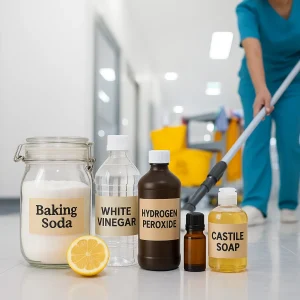
Natural Tile Cleaning Essentials
Best Ingredients & Products to Clean Bathroom Tiles Naturally
If you’re aiming for a sparkling clean bathroom without relying on harsh or chemical-based products, these natural cleaning ingredients are your go-to solutions. Each offers a safe, effective, and environmentally friendly way to clean bathroom tiles, eliminate grime, and maintain a healthy indoor environment.
1. Baking Soda
Baking soda is a gentle but powerful natural abrasive that helps lift dirt, grime, and mildew from both tile surfaces and grout lines. It also neutralizes unpleasant bathroom odors, making it an excellent deodorizer. When mixed with vinegar or lemon juice, it reacts to form a fizzy cleaning agent that loosens buildup and breaks down stubborn stains effectively.
2. White Vinegar
White vinegar is a versatile natural cleaner known for its ability to dissolve hard water stains, soap scum, and mineral buildup. Its mild acetic acid content also prevents mold growth and leaves tiles looking refreshed. However, it’s important not to use vinegar on natural stone tiles like marble or granite, as it can erode their surface over time.
3. Hydrogen Peroxide
Hydrogen peroxide is a non-toxic disinfectant that kills mold spores, bacteria, and viruses without releasing harmful fumes. It is especially effective on organic stains and helps whiten discolored grout over time. Use it directly on problem spots or mix with baking soda for deeper cleaning and stain removal on tiled surfaces.
4. Essential Oils
Tea tree and eucalyptus essential oils provide natural antibacterial and antifungal benefits, making them ideal for bathroom use. They add a fresh scent to your homemade cleaners and enhance the mold-fighting power of solutions like vinegar. Just a few drops can transform your cleaner into a pleasant-smelling and more effective product.
5. Castile Soap
Castile soap is a vegetable-based, biodegradable soap that’s perfect for cleaning delicate surfaces like ceramic tiles. It’s gentle enough for use in homes with children or pets, yet strong enough to cut through soap scum and grime when combined with warm water. It can be used as a base for DIY cleaning solutions or as a standalone natural cleaner.
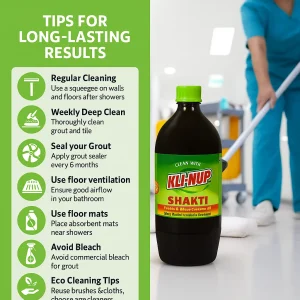
Bathroom Cleaning Tips
Tips for Long-Lasting Results
- Regular Cleaning: Use a squeegee on your walls and floors to prevent the buildup of hard water stains and spots after showers.
- Weekly Deep Clean: Every week, put aside one day to thoroughly clean the bathroom grout and tile.
- Seal your grout: Mix in a grout sealer every 6 months to help stop your grout from getting discoloured or mouldy. Moisture has a hard time getting to sealed tile grout, and it is easy to keep clean.
- Regular ventilation: Good airflow in your bathroom will prevent the buildup of bathroom mould. If necessary, fit a humidity sensor fan.
- Use floor mats: Place absorbent mats near showers to keep floor tiles dry and clean. Avoid rubber-backed mats that trap moisture underneath.
- Avoid Commercial Bleach for Cleaning Grout: It can make your tile grout white for a short interval, but it does damage over time to the tile.
- Spot treat quickly: If you see any stains on your tile, right away use the baking soda and vinegar solution to clean them quickly.
- Home steam cleaning: Remove dirt and bacteria with a Steam Cleaner on your walls and floor tiles at least once a month. This is suitable for homes where you share your home with kids or pets.
- Eco Cleaning Tips: You can take part in eco cleaning by reusing both old toothbrushes and cloths. Mix your own household cleaner in glass spray bottles to help the environment.
If you want something quick, eco-friendly brands like Klinol make cleaners that are ready to use, dry fast and are safe for you and your home. Washing bathroom tiles is only the beginning; caring for them will make them look clean and sparkling for a long time.
Conclusion
Harsher cleaning solutions are unnecessary for a spotless bathroom. You can eliminate it from hard water stains, fading floor tiles and tough bathroom mould with an easy solution and simple items. Regular practice and the proper technique are very important. A clean bathroom shows good hygiene and also supports mental health. Entering a clean bathroom with a nice scent can immediately put you in a good mood. Keeping tile grout clean and preventing ceramic cleaning deterioration are crucial for every home. That means the next time you are asked how to clean the bathroom tiles, you have the answer as well as the experience. Try these ideas and see how they change your bathroom.
For comprehensive guidance on natural cleaning methods, including effective DIY recipes using ingredients like baking soda, vinegar, and castile soap, you can refer to Healthline’s article: 18 Easy and Green DIY Recipes to Clean All the Things, Plus Health Benefits. This resource offers a variety of eco-friendly cleaning solutions suitable for various household needs
FAQ’s
1. What are some easy methods for natural cleaning of bathroom grout?
Applying a baking soda paste and then spraying on some vinegar is an effective natural way to clean bathroom grout. Scrub very gently with a soft brush after allowing the liquid to sit in place for 10–15 minutes. Another time-saving choice is to use Klinol’s bathroom cleaner straight on the grout without having to mix it.
2. Is it possible to get rid of hard water stains from tiles by avoiding acid-based cleaners?
Yes! Working with diluted white vinegar and hot water efficiently cleans away hard water stains. Spray the cleaner, let it rest and then wipe the surface. Because Klinol is plant-based, it is safe to use on any ceramic or floor tile since it relies on natural ingredients.
3. When should I conduct a thorough cleaning of the bathroom tiles?
It helps to clean bathrooms every week and to deeply clean them once every 7–10 days. Using Klinol frequently keeps the tile grout white and stops mould from building up in the bathroom.
4. Can the mould in the corners of tiles be tackled with any natural methods?
Yes. Put hydrogen peroxide on the mouldy area and scrub after 10 minutes. If you have limited time and just want one product, Klinol ensures your tile edges and corners are safe and clean without causing any harm to your family.
5. Is it safe to keep cleaning ceramic tiles with vinegar and baking soda often?
Yes, except if your floor is made of marble. Regular ceramic cleaning is well-maintained using this pair of products. For an easy, pH-suitable method, Klinol’s cleaner works well, it is safe, will not corrode and cleans your tiles while still allowing them to shine.

